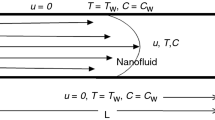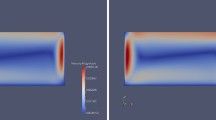Abstract
The present study deals with the finite element discretization of nanofluid convective transport in an enclosure with variable properties. We study the Buongiorno model, which couples the Navier–Stokes equations for the base fluid, an advective-diffusion equation for the heat transfer, and an advection-dominated nanoparticle fraction concentration subject to thermophoresis and Brownian motion forces. We develop an iterative numerical scheme that combines Newton’s method (dedicated to the resolution of the momentum and energy equations) with the transport equation that governs the nanoparticles concentration in the enclosure. We show that the Stream-Upwind Petrov–Galerkin regularization approach is required to solve properly the transport equation in Buongiorno’s model, in the Finite Element framework. Indeed, we formulate this ill-posed equation as a variational problem under mean value constraint. Numerical analysis and computations are reported to show the effectiveness of our proposed numerical approach in its ability to provide reasonably good agreement with the experimental results available in the literature.










Similar content being viewed by others
Data availability
Data sharing not applicable to this article as no datasets were generated or analyzed during the current study.
References
Kleinstreuer C, Xu Z (2016) Mathematical modeling and computer simulations of nanofluid flow with applications to cooling and lubrication. Fluids 1(2):16
Manca O, Jaluria Y, Poulikakos D (2010) Heat transfer in nanofluids Adv Mech Eng
Minkowycz W, Sparrow EM, Abraham JP (2012) Nanoparticle heat transfer and fluid flow, vol 4. CRC Press, New York
Sarkar S, Ganguly S, Biswas G, Saha P (2016) Effect of cylinder rotation during mixed convective flow of nanofluids past a circular cylinder. Comput Fluids 127:47–64
Sun XH, Yan H, Massoudi M, Chen ZH, Wu WT (2018) Numerical simulation of nanofluid suspensions in a geothermal heat exchanger. Energies 11(4):919
Ardahaie SS, Amiri AJ, Amouei A, Hosseinzadeh K, Ganji D (2018) Investigating the effect of adding nanoparticles to the blood flow in presence of magnetic field in a porous blood arterial. Inf Med Unlocked 10:71–81
Salloum M, Ma R, Weeks D, Zhu L (2008) Controlling nanoparticle delivery in magnetic nanoparticle hyperthermia for cancer treatment: experimental study in agarose gel. Int J Hypertherm 24(4):337–345
Baïri A (2018) Effects of ZnO–H\(_2\)O nanofluid saturated porous medium on the thermal behavior of cubical electronics contained in a tilted hemispherical cavity. an experimental and numerical study. Appl Therm Eng 138:924–933
Baïri A, Laraqi N, Adeyeye K (2018) Thermal behavior of an active electronic dome contained in a tilted hemispherical enclosure and subjected to nanofluidic Cu-water free convection. Eur Phys J Plus 133(3):1–11
Buongiorno J (2005) Convective transport in nanofluids. J Heat Transf 128(3):240–250
Mahian O, Kianifar A, Kalogirou SA, Pop I, Wongwises S (2013) A review of the applications of nanofluids in solar energy. Int J Heat Mass Transf 57(2):582–594
Li J, Kleinstreuer C (2008) Thermal performance of nanofluid flow in microchannels. Int J Heat Fluid Flow 29(4):1221–1232
Li Q, Wang J, Wang J, Baleta J, Min C, Sundén B (2018) Effects of gravity and variable thermal properties on nanofluid convective heat transfer using connected and unconnected walls. Energy Convers Manag 171:1440–1448
Xu Z, Kleinstreuer C (2014) Computational analysis of nanofluid cooling of high concentration photovoltaic cells. J Therm Sci Eng Appl 6:3
Jabbari F, Rajabpour A, Saedodin S (2017) Thermal conductivity and viscosity of nanofluids: a review of recent molecular dynamics studies. Chem Eng Sci 174:67–81
Addad Y, Abutayeh M, Abu-Nada E (2017) Effects of nanofluids on the performance of a pcm-based thermal energy storage system. J Energy Eng 143(4):04017006
Khodadadi H, Aghakhani S, Majd H, Kalbasi R, Wongwises S, Afrand M (2018) A comprehensive review on rheological behavior of mono and hybrid nanofluids: effective parameters and predictive correlations. Int J Heat Mass Transf 127:997–1012
Fan J, Wang L (2011) Review of heat conduction in nanofluids. J Heat Transf 133:4
Kakaç S, Pramuanjaroenkij A (2009) Review of convective heat transfer enhancement with nanofluids. Int J Heat Mass Transf 52(13–14):3187–3196
Buongiorno J, Venerus DC, Prabhat N, McKrell T, Townsend J, Christianson R, Tolmachev YV, Keblinski P, Lw Hu, Alvarado JL et al (2009) A benchmark study on the thermal conductivity of nanofluids. J Appl Phys 106(9):094312
Kumar LH, Kazi S, Masjuki H, Zubir M (2021) A review of recent advances in green nanofluids and their application in thermal systems. Chem Eng J 429:132321
Wen D, Ding Y (2004) Experimental investigation into convective heat transfer of nanofluids at the entrance region under laminar flow conditions. Int J Heat Mass Transf 47(24):5181–5188
Li CH, Peterson G (2010) Experimental studies of natural convection heat transfer of Al\(_2\)O\(_3\)/Di water nanoparticle suspensions (nanofluids). Adv Mech Eng 2:742739
Ho C, Liu W, Chang Y, Lin C (2010) Natural convection heat transfer of alumina-water nanofluid in vertical square enclosures: an experimental study. Int J Therm Sci 49(8):1345–1353
Putra N, Roetzel W, Das SK (2003) Natural convection of nano-fluids. Heat Mass Transf 39(8–9):775–784
Chon CH, Kihm KD, Lee SP, Choi SU (2005) Empirical correlation finding the role of temperature and particle size for nanofluid (Al\(_2\)O\(_3\)) thermal conductivity enhancement. Appl Phys Lett 87(15):153107
Amidu MA, Addad Y, Riahi MK, Abu-Nada E (2021) Numerical investigation of nanoparticles slip mechanisms impact on the natural convection heat transfer characteristics of nanofluids in an enclosure. Sci Rep 11(1):1–24
Galeão AC, Do Carmo EGD (1988) A consistent approximate upwind Petrov–Galerkin method for convection-dominated problems. Comput Methods Appl Mech Eng 68(1):83–95
Yurun F (1997) A comparative study of the discontinuous Galerkin and continuous supg finite element methods for computation of viscoelastic flows. Comput Methods Appl Mech Eng 141(1):47–65
Erath C, Praetorius D (2019) Optimal adaptivity for the supg finite element method. Comput Methods Appl Mech Eng 353:308–327
ten Eikelder M, Akkerman I (2018) Correct energy evolution of stabilized formulations: the relation between vms, supg and gls via dynamic orthogonal small-scales and isogeometric analysis. ii: The incompressible Navier–Stokes equations. Comput Methods Appl Mech Eng 340:1135–1154
Bänsch E, Faghih-Naini S, Morin P (2020) Convective transport in nanofluids: the stationary problem. J Math Anal Appl 489(1):124151
Bänsch E (2019) A thermodynamically consistent model for convective transport in nanofluids: existence of weak solutions and fem computations. J Math Anal Appl 477(1):41–59
Shekar BC, Kishan N (2015) Finite element analysis of natural convective heat transfer in a porous square cavity filled with nanofluids in the presence of thermal radiation. J Phys 662:012017
Balla CS, Naikoti K (2016) Finite element analysis of magnetohydrodynamic transient free convection flow of nanofluid over a vertical cone with thermal radiation. Proc Inst Mech Eng N 230(3):161–173
Ullah N, Nadeem S, Khan AU (2020) Finite element simulations for natural convective flow of nanofluid in a rectangular cavity having corrugated heated rods. J Therm Anal Calorim 143:4169
Girault V, Raviart PA (2012) Finite element methods for Navier–Stokes equations: theory and algorithms, vol 5. Springer, Berlin
Taylor C, Hood P (1973) A numerical solution of the Navier–Stokes equations using the finite element technique. Comput Fluids 1(1):73–100
Apel T, Randrianarivony HM (2003) Stability of discretizations of the stokes problem on anisotropic meshes. Math Comput Simul 61(3–6):437–447
Abu-Nada E, Chamkha AJ (2010) Effect of nanofluid variable properties on natural convection in enclosures filled with a CuO-Eg-water nanofluid. Int J Therm Sci 49(12):2339–2352
Khanafer K, Vafai K (2017) A critical synthesis of thermophysical characteristics of nanofluids. Nanotechnology and energy. Springer, Berlin, pp 279–332
Franca LP, Hauke G, Masud A (2004) Stabilized finite element methods. International Center for Numerical Methods in Engineering (CIMNE), Barcelona
John V, Novo J (2013) A robust supg norm a posteriori error estimator for stationary convection–diffusion equations. Comput Methods Appl Mech Eng 255:289–305
ten Eikelder M, Akkerman I (2018) Correct energy evolution of stabilized formulations: the relation between vms, supg and gls via dynamic orthogonal small-scales and isogeometric analysis. i: The convective-diffusive context. Comput Methods Appl Mech Eng 331:259–280
Burman E (2010) Consistent supg-method for transient transport problems: stability and convergence. Comput Methods Appl Mech Eng 199(17):1114–1123
Bochev PB, Gunzburger MD, Shadid JN (2004) Stability of the supg finite element method for transient advection–diffusion problems. Comput Methods Appl Mech Eng 193(23):2301–2323
Russo A (2006) Streamline-upwind petrov/galerkin method (supg) vs residual-free bubbles (rfb). Comput Methods Appl Mech Eng 195(13):1608–1620 (a Tribute to Thomas J.R. Hughes on the Occasion of his 60th Birthday)
Brooks AN, Hughes TJ (1982) Streamline upwind/Petrov–Galerkin formulations for convection dominated flows with particular emphasis on the incompressible Navier–Stokes equations. Comput Methods Appl Mech Eng 32(1–3):199–259
Franca LP, Frey SL, Hughes TJ (1992) Stabilized finite element methods: I. application to the advective–diffusive model. Comput Methods Appl Mech Eng 95(2):253–276
Gelhard T, Lube G, Olshanskii MA, Starcke JH (2005) Stabilized finite element schemes with lbb-stable elements for incompressible flows. J Comput Appl Math 177(2):243–267
Burman E, Smith G (2011) Analysis of the space semi-discretized supg method for transient convection–diffusion equations. Math Models Methods Appl Sci 21(10):2049–2068
Burman E (2010) Consistent supg-method for transient transport problems: stability and convergence. Comput Methods Appl Mech Eng 199(17–20):1114–1123
John V, Novo J (2011) Error analysis of the supg finite element discretization of evolutionary convection–diffusion–reaction equations. SIAM J Numer Anal 49(3/4):1149–1176
Ciarlet PG (2002) The finite element method for elliptic problems. Society for Industrial and Applied Mathematics
Ern A, Guermond JL (2013) Theory and practice of finite elements, vol 159. Springer, Berlin
Astanina MS, Kamel Riahi M, Abu-Nada E, Sheremet MA (2018) Magnetohydrodynamic in partially heated square cavity with variable properties: discrepancy in experimental and theoretical conductivity correlations. Int J Heat Mass Transf 116:532–548
Benedetto M, Berrone S, Borio A, Pieraccini S, Scialò S (2016) Order preserving supg stabilization for the virtual element formulation of advection–diffusion problems. Comput Methods Appl Mech Eng 311:18–40
Wervaecke C, Beaugendre H, Nkonga B (2012) A fully coupled rans Spalart–Allmaras supg formulation for turbulent compressible flows on stretched-unstructured grids. Comput Methods Appl Mech Eng 233–236:109–122
Alosious S, Sarath S, Nair AR, Krishnakumar K (2017) Experimental and numerical study on heat transfer enhancement of flat tube radiator using Al\(_2\)O\(_3\) and CuO nanofluids. Heat Mass Transf 53(12):3545–3563
Chen YJ, Wang PY, Liu ZH (2016) Numerical study of natural convection characteristics of nanofluids in an enclosure using multiphase model. Heat Mass Transf 52(11):2471–2484
ANSYS (2016) ANSYS Fluent - CFD Software|ANSYS
Author information
Authors and Affiliations
Corresponding author
Ethics declarations
Conflict of interest
The authors have no conflicts of interest to declare that are relevant to the content of this article.
Additional information
Publisher's Note
Springer Nature remains neutral with regard to jurisdictional claims in published maps and institutional affiliations.
Appendices
Appendix 1: Density dimensionless derivation
note also from Eq. (2.4),
where \((\rho \beta )_\text {bf}=\rho _\text {bf}\beta _\text {bf}\) and \((\rho \beta )_\text {np}=\rho _\text {np}\beta _\text {np}\). Hence
Let
Appendix 2: Momentum equation
Moving toward dimensionless variables the above equation becomes
Multiplying the above equation by \(\dfrac{L^3}{\alpha ^2}\) we obtain
which rewrites using the non-dimensional constants as follows:
where
Appendix 3: Energy equation
The dimensional energy equation writes
Moving toward dimensionless variables the above equation writes
Multiplying the above equation by \(\dfrac{L^2}{\alpha (\theta ^{\star }_{H}-\theta ^{\star }_{C})}\) we obtain
which rewrites using non-dimensional variables as follows:
where

Appendix 4: Nanoparticle transport equation
The particle dimensional equation writes
using the non-dimensional equations the above equation writes
Multiplying the above by \(\dfrac{L^2}{\alpha \phi _\text {b}}\) we obtain
where
Rights and permissions
About this article
Cite this article
Riahi, M.K., Ali, M., Addad, Y. et al. Combined Newton–Raphson and Streamlines-Upwind Petrov–Galerkin iterations for nanoparticles transport in buoyancy-driven flow. J Eng Math 132, 22 (2022). https://doi.org/10.1007/s10665-021-10205-4
Received:
Accepted:
Published:
DOI: https://doi.org/10.1007/s10665-021-10205-4
Keywords
- Advection-dominated equation
- Finite element method
- Nanofluid
- Nanofluid heat transfer
- Navier–Stokes equations
- Newton–Raphson method
- Stream-Upwind Petrov–Galerkin




